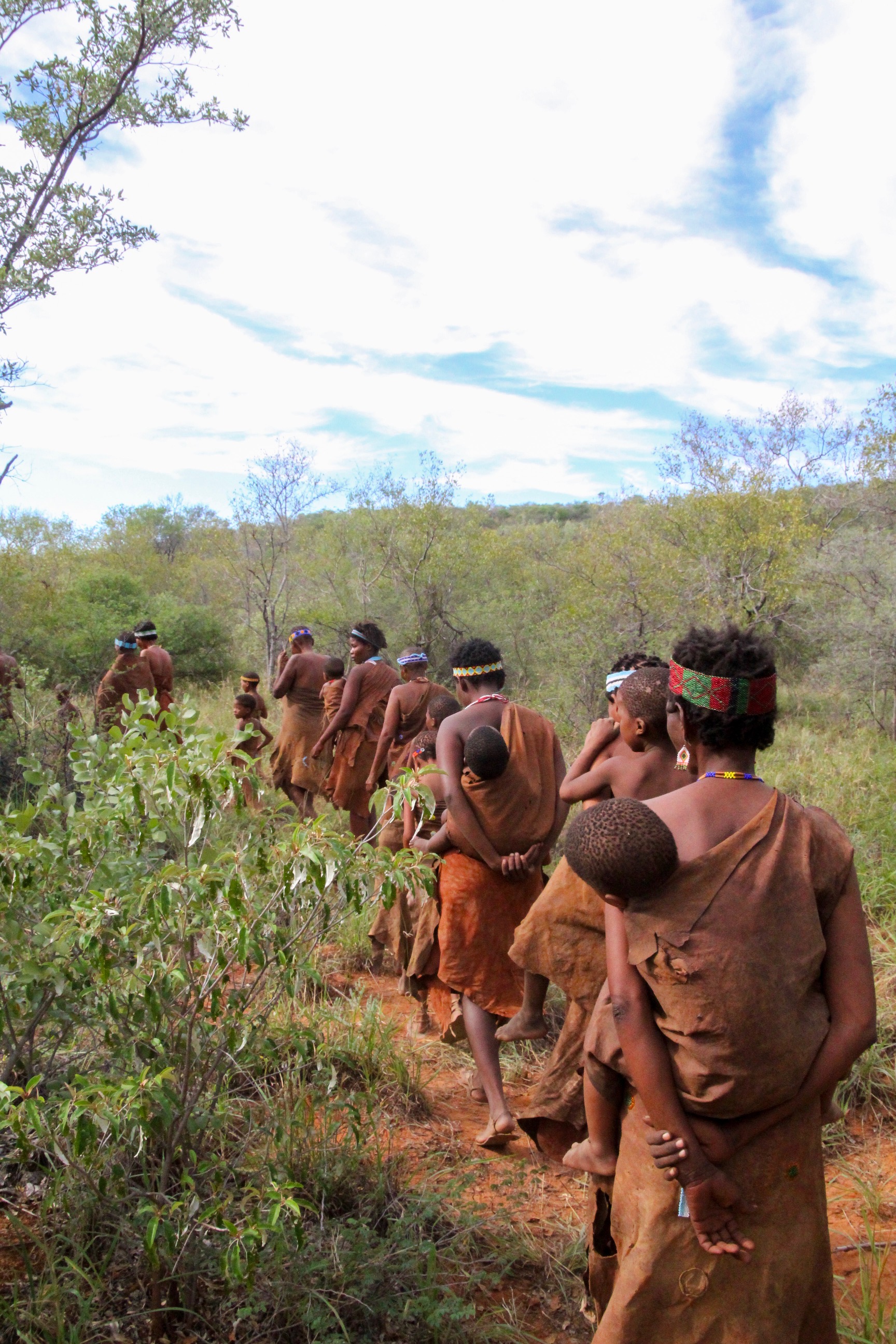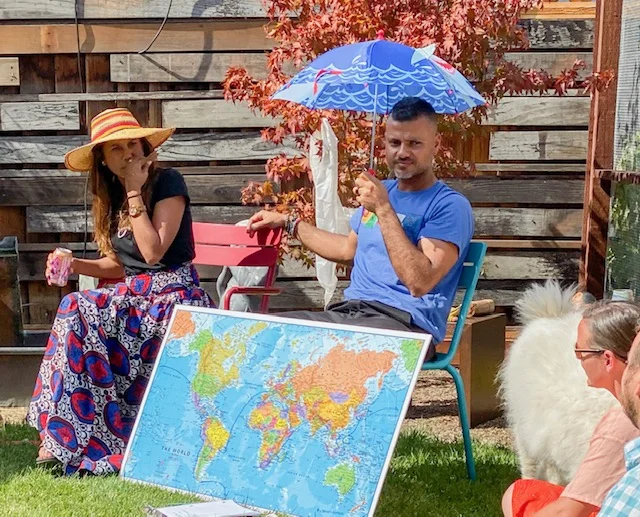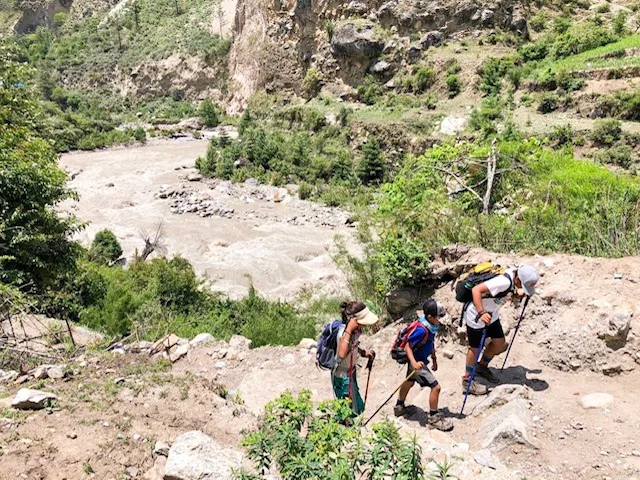Botswana and the KhoiSan: Deepening the Learning
Quick Apology: I am so sorry for all of my typos in these posts. I write these posts late at night and my eyes don’t seem to catch the mistakes until I do another read the next day. By then I correct the mistakes on Squarespace, but it is too late for the corrections to be reflected on the email message. Thank you for your continued generosity of patience with my hasty work!
—-
This is the third post of a 4-part series on our experience in the remote Kalahari Desert of Botswana with the “Bushmen” or KhoiSan people from the Ju!Hoansi Tribe back in April 2019. See our Instagram Story Highlights Botswana here for quick videos, though a longer video will be created in the next several weeks and shown on our YouTube Channel (please subscribe here). Our website is the best place to sign-up for email updates of new posts! Thank you for sharing in this adventure.
—-
Cover Photo: Walking into the Bush with the KhoiSan.
Brief Background on the KhoiSan
The ancestors of the hunter-gatherer San people are thought to have been the first inhabitants of what is now Botswana and South Africa, but generally covered the desert regions of modern-day Namibia, Angola, Zambia, Zimbabwe, and Lesotho. The historical presence of the San people in Botswana is particularly evident in northern Botswana's Tsodilo Hills and Namibia’s Damaraland regions, in which the stone tools and rock art paintings found there, date back over 70,000 years (making them the oldest known art on Earth). The San people were traditionally semi-nomadic, moving seasonally within certain defined areas based on the availability of resources such as water, game animals, and edible plants. As such, they have an enormous amount of indigenous wisdom as to how to live off of the land. With an estimated 90,000 KhoiSan people living in the world today, the majority live in Botswana. According to the Botswana government’s census of 2010, San populations in Botswana numbered about 50,000 to 60,000, grouped into approximately 18 sub-group communities or tribes that don’t share much connectivity with each other, and in most cases, the rest of the world.
Originally, the term “Khoe” in Nama (which is a widespread non-Bantu language that has clicks) meant “human person” and “San” referred to “people” or “outsiders”. Together, KhoiSan referred to people of the desert who generally had the following characteristics, spoke in click tongues, had a milk chocolate complexion, triangle-shaped face, carried a reserve of fat on their bums, and prone to wrinkled skin. Years later during the 17th century, the Dutch colonists began calling the San people “Bosjesmans” in Dutch or “Boesmans” in Afrikaans which literally meant, “bandit” or “outlaw”. Over time, the term later turned into “Bushmen” in English. Today, there is yet another Bantu term in Tswana language. It is a collective term for these particular people that live in Botswana, “Basarwa,” which means "those who do not rear cattle."
Both KhoiSan and Bushmen are exonyms, or external names, as internally, there was no need to label themselves as any “kind of people,” until others arrived and felt the need to identify them. It is funny how that happens throughout history. Indigenous cultures are often “named” in an effort to describe them as “other” and then all too often, the “other” classifications justify some discriminatory treatment by those on the “inside” of defined power.
The “Bushmen” have been mocked, outcast, and discriminated against for centuries. By many Africans, the San people are seen as inferior and poverty-stricken, which is increasingly true as they become more Westernized. Politically, they have had no representation in governments of the nations they live in. In fact, though outdated in practice (last permit granted was in 1936), until 1969 it was legal to “hunt” Bushmen for sport according to South African laws. In an effort to uphold their rightful honor, our family refers to these people as San people, or even KhoiSan, as both are widely accepted by them in positive contexts…and wherever appropriate, we will refer to the specific people as the Ju!Hoansi tribe (where the “!” is a specific sound of one of over seven different types of clicks).
Having said all of this, it should come as no surprise that while traveling in Africa, if ever, we mentioned to any locals that we were going to spend time with the “Bushmen” we would hear a combination of admiration and marginalization. Of the “Bushmen’s” avid hunting acumen we heard nothing but praise, but then in the same breath, they would mention that the “Bushmen” eat just about anything and that they didn’t integrate with the rest of the cultures, in a way that pejoratively connoted their primitivism.
Now, as true Bay Areans, we only “shoot” with cameras and have confined our concept of “living off the land” to backyard gardens and chickens, with an occasional fishing expedition. Still, since Zayan was a young boy, he has always wanted to “hunt for his food” and now this was going to be his chance to learn about the indigenous tracking and hunting techniques of the San people.
I should also note, here, that as we binge watched travel shows the years before our trip, we learned about Botswana’s hardline against trophy hunting in game reserves. Though we understand that there are some who see game reserve hunting as potential conservation income (only allowing the oldest animals to be hunted for a large sum of money), we have concluded that the all too common corruption or misdirection of funds, leaves this “population control” method to be, at best, flawed and at worst, inhumane. What we never thought through, as most probably haven’t, is the dependence on hunting as sustenance for many of the indigenous cultures in that area.
The San people’s way of life is to forage, track, and hunt. Their nomadic living style, rituals, and in fact, their identity, revolves around finding their food. They are careful to take only what they need, as evidenced even in foraging (where they will uncover a plant to take one root and then rebury the plant in a way that allows it to continue living) and one animal can feed the community for days. Therefore, Botswana’s criminalization of ALL forms of hunting, has emasculated the Ju!Hoansi. This will be more thoroughly addressed in the next post where I tell you more about how they live today, when they are not in the Bush and also an interesting solution to this problem that is currently underway. For the purposes of this post, suffice it to say, we were all a little surprised (and Zayan disappointed) to learn that our experiential learning would be limited to foraging and tracking.
Learning from the KhoiSan during one of the Bush Walk breaks,
Baboons in the Bush
Those of you who follow our travels on social media, know that one of our family travel rules has been that we try any food once, as long as it is not endangered or illegal. As such, we have tried a lot of new foods from more “normal” types like alpaca and reindeer to farther fetched, dung-beetle larva and mopani worms. This was an area that I perceived we had in common with the Ju!Hoansi.
Nearby our campsite, a troop of baboons took refuge in some taller trees on the hill. At night, when I heard sounds that sounded like shouts and post-sneeze expressions, I was convinced that I was hearing the neighboring KhoiSan. After all, our sites were so close that we could hear them sing and dance from our tents.
One morning, after being convinced that the Ju!Hoansi had not slept at all the night before, due to all the sounds they were making, I asked our guide, Kavaa if they were O.K. (in a concerned tone). He looked at me quizzically and I explained that I thought that I heard the KhoiSan kids being fearful of some animal that was likely coming for the remaining goat meat. I told him that I could hear the San people guarding the village to scare animals away and that I hoped that they were alright. In true amusement, Kavaa let out a deep belly laugh at my remarks. He then said that on the contrary, the Ju!Hoansi slept very well and what I heard was the troop of baboons trying to defend themselves from a hungry leopard that had tried to take one of the babies! Well, this wasn’t the first time I mistakenly heard “someone” instead of “something.” In an effort to make light of my mix-up, I cracked a joke, “I guess if the Ju!Hoansi were awake it was only to wish that they could hunt those baboons for themselves.” This time, Kavaa didn’t laugh at all. He said, “No, they don’t eat baboons because they are too human. You even thought they were humans!” Not only did I learn that the notion that “Bushmen eat everything and anything” was false, but I was left wondering if we needed to amend our family travel rule…
Zayan and Kaysan learning how to start a fire.
Daily Bush Walks
While the Ju!Hoansi are not allowed to hunt, they still spend days foraging out in the Bush and stock up on medicinal plant roots, greens, fruits, and nuts to eat when they are back at the nomadic village. On two separate days, we went out into the Bush with the full group (for about four hours each time) and learned from their wisdom.
Before leaving for the Bush Walks, the old boys would throw sticks on the ground and talk amongst themselves as to what messages the ancestors were sending them through the pattern in which the sticks fell. The rest of the group watched and patiently waited for the old boys to announce the direction of their walk. Then in a long line of men, women, and children, in no particular order, the group followed each other out into the Bush. Some of the men carried homemade hunting/foraging tools, like long sticks with hooks at the end, arrows, etc. and the women carried babies.
We joined the line in our trail shoes and carrying bottles of water and day packs, and weaved in and out of thorny branches, somewhat clumsily at times. I was impressed that many of the kids and adults walked barefoot through the thorny path and others, with thin sandals made from skins. As they found nuts or plants along the way, the San people would organically disperse and start foraging, sometimes passing around their bounty as a snack, and at other times, collecting the spoils and storing them in a make shift backpack by retying their upper skins.
In this way, we learned about important plants, medicinal roots and nuts hidden within seeds...and we sampled some amazing fruits and herbs. We often collected seeds/nuts that had had been vomited out by Kudus as they were still good to eat, but these were distinguished from the ones we were not to eat, found in their poop (as they had gone through the whole body process and stomach acid would have spoiled them through their hard shells). When we found wild Baobab trees, the group would stand around and hurl their walking stick tools and other items at the highest fruits to knock them down. This activity invited friendly competition and loud cheers from within the group and our family was perhaps the loudest!
Along the way, the KhoiSan would point out different tracks of animals and insects to us, and each other. Over the two days, they spotted tracks and/or dung of elephants, porcupine, scorpions, leopard, kudu, and snakes. Some of these signs would be used to guide the group further towards better foraging grounds, and other times it served as a sign of danger. The kids loved the Bush walks, despite the heat and the occasional injury from thorns or bee stings (see Kaysan’s Journal entry below).
As a mom of three, I was most struck by the way the women collectively mothered the children as they walked. They all watched out for the little ones and were quick to help each other as they needed it. Even with our kids, the women were attentive and twice, helped us remedy a thorn prick or a bee sting with leaves for bandages and dirt for anti-sting ointment. The most impressive mothering activity, however, was watching the women nurse their babies on the go. While walking, if the babies (carried in skins on their mom’s back) got hungry, they would be shifted in the skin to nurse while the mom continued walking! And somehow, without diapers, the mothers would anticipate the babies poop/pee and move them out of their skin wraps and over the dirt at exactly the right times! Boy, I wish I had learned a few things from them when I was in that stage of motherhood!
After a few hours of walking, the group would find some shade and sit and rest in a clearing. Never did I see them drink water during these walks, even the nursing moms. In fact, when one of our kids asked for the water bottle at the break. I felt guilty and mumbled to the kids that they should drink sparingly. so as not to show off to the others. One of my friends in the group overheard me and told Kavaa to tell me to let the kids drink. She said that their bodies were used to less water, but that theirs were not. For lacking a common spoken language, they were so attuned to our every need and so ready to offer care and support, that it was beautifully humbling.
Despite the heat of the day, when the Ju!Hoansi rested on the Bush walks, they made a small fire from sticks and grass. It was not to keep the bugs out, nor protect them from animals, though I’m sure it helped in those aspects too. Instead, the fire was built to light their pipes. Men and women alike smoked tobacco heavily throughout our time with them. Their corresponding coughs were often quite severe, but not a deterrent in any shape or form, from what we could tell. Personally, these smoke breaks were my favorite times because it was when we could talk about anything on our minds. Looking back now, there is so much I wish I would’ve asked, but in those moments, it was still all about finding common ground, and less about learning through interrogations and interviews.
During Bush Walk breaks, the boys often played a competitive stick game, that the KhoiSan children play as a way to strengthen their throwing accuracy for hunting/gathering.
The Porcupine Hunt
On one of the days, the group was intent on tracking and pseudo-hunting a porcupine. We went deep into the Bush and found an enormous old termite mound that was thought to have been housing a porcupine.
For the next hour or so, the young men of the group worked diligently to take turns and dig out large holes (each about four to six feet deep) with a stick and the one modern tool they borrowed from Rob, a shovel. While one man dug and another crawled into the primary tunnel entrance to instruct the digger, others watched for possible porcupine escapes. The old boys, meanwhile, found a good place for a smoke and only stopped for intermittent spot-checks as the young boys got closer to the porcupine’s den. We all watched in suspense as the young men got deeper and deeper into the ground and then followed the tunnel to yet another location, only to dig again. In the end, after so much effort and patience, the porcupine was nowhere to be found. It seems that the tracks that were spotted were in fact older than they the men initially thought, though from the den (which was eventually fully revealed) it was clear that the porcupine hadn’t been gone for too long.
The fact that they turned up empty-handed after so much energy expended on the attempt, seemed par for the course for the Ju!Hoansi. It was a good reminder that a “hunt” didn’t always amount to instant gratification and likely would not preclude similar effort in the future. Once again, this lesson had deep implications for all of us…but in that moment, we all applauded the efforts of those involved and made our way back to camp.
Standing guard for porcupine escapes.
Trying to find the porcupine den.
Going headfirst into the porcupine burrow while we all prayed that his face wouldn’t get injured by one defending itself.
---
Excerpt from Kaysan’s Journal (Age 7)—April 2019:
What we did with the Bushmen was we walked with them, we chilled with them and one of the hikes, the one bushman that had jackal hare on his butt was holding a scorpion!!! He sed it is for kids to play with!!! We also found our favorite fruit there. It was called a marula fruit. While we were with the Bushmen I noticed that some of the women showed their boobis. Sumtimes we would go there at nihgt and see them dance.
On one of the days, there was a bee on my cheek, when I slapped the bee, it stung me! When Daddy came over he asked someone for tweezers but Kava said no you should use a knife to get it out. Then Kavaa took the stinger out with a side of the knife and put dirt on it. The sting did not hert too bad after a while.
One day we were walking through the bush with the bushmen and I was cut by a thorn on a branch. One of the bush woman helped by taking a leaf and using it as a bandaj by rapping it around my cut. When she was rapping it my finger was hurting but the pain went away after a while.
After all the bushmen experience was very interesting and diffrent. They wore diffrent clothes and played games with scorpions. They are very smart because they made a trap for a bird. They did this by putting a piece of food in the trap and when the bird tried to peck the food there would be a rope that wuld grab the bird around the neck and trap it but keep it alive. When Zayan and I tested the trap it caught our fingers!



























